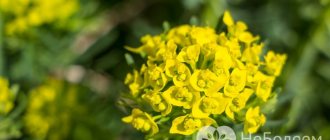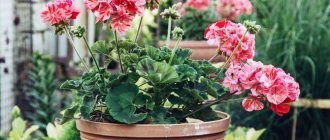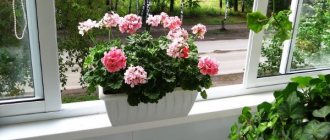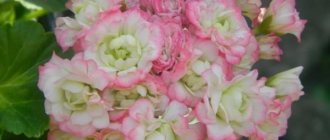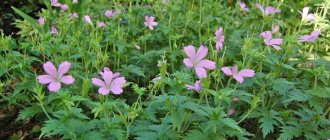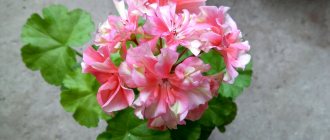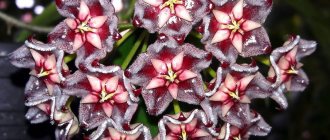Geranium is a favorite of many gardeners who prefer houseplants, due to its unpretentiousness not only in the conditions of its maintenance, but also in its methods of propagation.
One of the simplest is the cutting method. In the article we will look at how to grow geranium from cuttings at home, methods of rooting cuttings and when it can be transplanted into a pot.
Is it possible to plant like this?
Due to the ability of geranium to survive and continue to grow even in unfavorable conditions, it can be propagated without the use of roots. But in general there are three ways to propagate this crop:
The first method takes too much time and patience, because in order to germinate the seeds, you need to provide strictly defined conditions, the second is quite risky, since the delicate roots are very easy to damage during their division, but the third, by cuttings, is preferred by most people involved in growing and breeding geraniums.
The main advantage of this method is the ability to propagate a plant without disturbing its roots, which guarantees the complete safety of the mother plant.
What is a cutting, how to choose and prepare it correctly?
A shoot, or cutting, is a cut part of a plant with one or more nodes.
This cut off part is precisely used for vegetative propagation (by cuttings). In order to get a new geranium, completely identical to the previous one, you first need to select this cutting. When should you take a cutting from the mother flower in order to plant and grow a young plant? The mother plant should be well developed and absolutely healthy, ideally it should be 2 - 3 years old. You need to select the apical cuttings of the mother geranium. This process should be 7–8 cm in length, have one or more nodes (buds, growth points) and 3–5 leaves. If there are leaves left at the base of the cutting, they must be carefully removed.
If the branches of the shoot are the same length as the shoot itself, then you definitely need to cut them off, and then you can use them as independent cuttings. And the finished shoots are left in the air so that the cut areas dry out. If after a few hours they are covered with a thin film, it means that everything went well and the cuttings are ready for the next stage.
Methods for propagating geraniums
Reproduction plays an important role in the agricultural technology of this crop. This procedure will not only increase the total number of plants, but will also rejuvenate old flowers. Young bushes take up less space, have a more attractive appearance, and produce abundant flowering.
Geranium flowers
There are two main methods of reproduction: vegetative and generative. Each of these methods has its own characteristics, advantages and disadvantages.
Vegetative (from shoots or cuttings)
With this method, geraniums are planted by cuttings in a pot or by dividing the bush. Cuttings are more popular due to their ease. In adult plants, the stem becomes elongated and bare, and the inflorescences bloom only on its upper part. The flower loses its attractiveness. To renew the bush, it is regularly pruned every year.
Cut shoots are rooted and cuttings are obtained. To get viable seedlings, you need to know how to plant geraniums in a pot without roots. In this way you can get several dozen cuttings. These simple manipulations allow you to renew the bush and propagate pelargonium.
Geranium cuttings
Reproduction by shoots is possible only if new shoots have appeared at the rhizome. Then the bush is carefully removed from the ground and divided so that the young plant has its own roots. It is necessary to separate young shoots from the mother plant when they are small.
For your information! For large sprouts, the roots will become intertwined and it will be quite difficult to separate them.
Generative (seeds)
Flower growers rarely use this propagation method, because the shoots obtained from the seeds differ from the parent bush. With the generative method of propagation, new varieties are developed. For effective reproduction in this way, the following factors must be taken into account:
- sowing time;
- soil quality;
- picking;
- rules of care.
Note! Seeds must be scarified. Therefore, before purchasing them, you need to check with the seller whether the seed material has been processed or not.
How to carry out the procedure?
The cut shoots do not yet have roots, which are necessary for the development of full-fledged geraniums, so after their preparation it is necessary to root the cuttings. This can be done in water or directly in the prepared substrate.
Rooting cuttings in water
How to propagate a plant by placing cuttings in water? The main advantage of this method is the ability to observe the process from beginning to end and not miss the moment when the shoot has roots and can already be planted in the substrate.
Prepare a small transparent container (disposable cups work great).- Pour settled water at room temperature into a container up to about half a glass (5 cm).
- Place the shoots in water.
- Change the water once every 2 days.
- After about a week (during this period the first roots should appear), transplant the rooted cuttings into the prepared substrate in a container of a suitable size.
Rooting in water also has its significant disadvantage: sometimes the cutting can rot before it even takes root, and in order to prevent this, gardeners strongly recommend adding crushed activated carbon to it for disinfection every time you change the water.
Using this method, you can get beautiful and healthy geraniums.
Rooting in the ground
Is it possible to plant a cutting without roots directly into the ground? Thanks to rooting in the ground, you don’t have to worry about the shoots rotting, since this happens extremely rarely, but you won’t be able to see when the roots will appear, which is why the planting material sometimes gets spoiled by being replanted ahead of time. How to plant correctly can be read in the instructions:
Prepare a substrate from garden soil and peat.- Place the prepared soil in a small container, moisten it generously and compact well.
- Choose a place with sufficient diffuse lighting. Cuttings really do not like scorching rays.
- Place the shoot into the substrate to a depth of 4–5 cm and again compact the soil around it.
- Waiting for new leaves to appear on the cuttings means that it has successfully taken root and is ready to be transplanted into a full-fledged pot. This will take about a month.
How to plant a geranium shoot without roots
Geranium rightfully occupies one of the places of honor on the list of favorite indoor plants. It is also successfully used to decorate balconies, terraces, garden plots and street flower beds. A variety of colors, unpretentiousness and ease of reproduction are the undoubted advantages of this plant.
The cutting method is one of the most common for propagating geraniums. It can be used all year round, but the best time for excellent results is spring. This method seems quite simple, but following a few rules will allow you to grow beautiful, spectacular plants.
Preparing geranium cuttings for planting
Eranium can be grown from seeds, root division and stem cuttings. To plant geraniums without roots, you need to correctly perform the pruning procedure. Tip cuttings are ideal for plant propagation. They should be cut under the bud so that the length is 7-8 cm and there are 3-5 leaves left on each of them. The cut should be oblique. The lower leaves are removed.
If after pruning the plant has long branches left, they can also be cut into cuttings of the same length with two to three pairs of leaves and used for rooting.
Finished cuttings should be left to air dry. After a couple of hours, the cut and places where the leaves are broken will be covered with a thin film. The cuttings are ready, it’s time to choose a rooting method.
Methods for growing geraniums from cuttings
Rooting a cutting can be done in two ways, taking into account their advantages and disadvantages.
Rooting geranium cuttings in water
Rooting stem cuttings is quite easy in water. To do this, you need to prepare containers filled with 5 cm of pre-settled water. It is better if the containers are made of dark glass. The cuttings are lowered into the water with the lower cut. The roots appear within a week.
The beauty of this method is that you can observe the rooting process and plant the plant in the ground at the right time. Disadvantage - the edge of the cutting, not having time to release the roots, can rot. To prevent rotting, experienced gardeners recommend adding activated carbon to the water. The water should be changed once every two days.
The shoots with roots are planted in the ground. If you follow the rules of care, such cuttings will produce beautiful, beautiful geranium bushes.
Rooting geranium cuttings in the ground
You can root geranium cuttings directly in the ground. Containers or pots with holes to drain excess water are suitable for this purpose. Good drainage is a prerequisite for excellent results. Ready cuttings are planted in moist soil at a distance of 2-3 cm from each other. The rooting process can last two to four weeks. The shoots are watered as the soil dries. To obtain lush bushes, the top bud is pinched.
The undoubted advantage of this method is that the plants take root better. The downside is when you think that the geranium has taken root and you start replanting it ahead of time, thereby losing some of the excellent planting material.
Conditions for growing geraniums
Good lighting, moderate watering and room temperature are the key to good rooting of cuttings. Old plants will also benefit from pruning. As a result, you will get a lot of luxurious geranium bushes. #CareTips
Transplanting into a pot: when and how?
A cutting that is placed in the ground produces roots only after a month, but unlike the method with water, the roots will not rot, so the likelihood of getting a new plant is very high.
- Remove the cuttings that have taken root from water or soil.
- Prepare the substrate: 2 parts turf soil, 1 part sand, 1 part humus, 1 part leaf.
- Choose the right size container: shallow and quite wide, because geraniums have a shallow root system.
- Place good drainage at the bottom of the pot.
- Place soil in a container and moisten it.
- Plant the sprout in the substrate and compact the soil around it a little.
- Place the pot with the plant on a well-lit windowsill.
A cutting rooted in water is replanted after a week, and one rooted in the ground after a month.
The dates presented above are approximate , so first of all you need to look at how the process develops.
Other ways to plant geraniums
How to propagate geranium at home
Beginning flower growers need to know the features of all propagation methods. This will allow them to get beautiful geranium bushes.
Seeds
Only varieties with non-double simple inflorescences can be propagated in this way. It is not possible to grow hybrid and varietal geraniums vegetatively. Geranium seeds are very small, so the soil for sowing them should be sifted, light, and consist of sand, peat and turf soil (1: 2: 2). The substrate is disinfected and moderately moistened. The surface of the soil is leveled and the seeds are laid out at a distance of 5 cm from each other, sprinkled with earth.
The containers with the crops are covered and placed in a dark, warm place. After the first shoots appear, the plantings need to be opened and exposed to light. The air temperature should not exceed 22 °C. At higher rates, the cotyledons become elongated.
Growing pelargonium from seeds
By dividing the rhizome
Perennial adult geranium bushes become cramped in a pot. In this case, geranium propagation is used by dividing the rhizome. It is cut in such a way that there is a growth bud on each segment. Division can only be done on healthy bushes; weakened and diseased plants will die. The harvested roots are planted in pre-prepared holes. The best time for the procedure is spring or autumn, when the plant’s energies are not directed towards flowering. All tools and materials must be clean and disinfected.
Important! During root division, dry, rotten roots are removed.
When can a flower be propagated in this way?
Geraniums can be propagated by cuttings all year round, but flower growers are of the opinion that during the dormant period (mid-autumn - end of winter) it is better not to touch the plant, because at this time it is very vulnerable, and therefore the mother geranium may die. Therefore, the most optimal period is spring, when geraniums begin their growing season and are still full of previously accumulated strength.
Propagation of a plant such as geranium is a fairly simple process that anyone who takes it upon can do it. And proper and timely care for a rooted plant will help it delight the eye with its attractive and aesthetic appearance.
If you find an error, please select a piece of text and press Ctrl+Enter.
Geranium is a well-known plant that almost all gardeners know and grow without problems. Or at least have experience in growing this unpretentious flower.
He loves rare, but at the same time abundant watering, he is not afraid of open air. Geranium is more associated with our grandmothers, but no one forbids those who are much younger from growing it. How to properly plant geraniums with shoots, including without roots, read on. Also watch a useful and interesting video on the topic.
Caring for young geraniums
Figs - growing at home, how to plant
Geranium is considered an unpretentious plant. The duration and abundance of flowering ensured its great popularity. Many varieties have a refined aroma. Even a novice gardener can cope with the care and cultivation of the crop. The health and visual attractiveness of the plant depend on the efforts of the grower. With proper maintenance, the crop retains its decorative properties, and its lifespan is at least 10 years.
Comfortable conditions for growing geraniums:
- loose soil;
- good lighting;
- comfortable air temperature (about 25 °C in summer, not higher than 16 °C in winter).
Spraying a flower
Spraying has a beneficial effect on the condition of geraniums. For the procedure, filtered and settled water is used. Watering is carried out regularly. In summer, moistening is carried out at the first signs of drying out of the soil.
To ensure full color, the plant must be fertilized every 2 months. It is best to choose complexes containing nitrogen. You should also prune regularly. In its absence, the bush becomes shapeless and loses its attractiveness.
Based on all of the above, the conclusion suggests itself that geranium is a useful and easy-to-care plant. Every flower lover should have one, having carefully studied the issue of planting a flower.
Landing Features
When to plant or transplant this flower? You should be guided by two criteria:
Appearance of the plant : if the flower grows very slowly, but is properly cared for, then this most likely means that it is time to plant it in another, larger pot.- Soil inside the pot : if after watering, the soil dries out quickly enough, this means that the roots of the flower have grown, and it’s time to change the pot to a larger one.
There is also a universal method that will help determine whether it is time for a transplant or not. You need to remove the plant from the pot and carefully examine the lump of earth. If the roots literally penetrate right through the ground and there are a lot of them, then it’s time to replant the plant.
Watch a video about transplanting geraniums:
General Tips
- Ideally, it is better to replant geraniums in the spring . It is necessary to prepare in advance a larger pot into which the flower will “move”.
- It is not necessary to replant the geranium into a new pot, but it must be disinfected . Also, to transplant geraniums you will need a watering can with water and fresh soil.
- It is not advisable to replant geraniums during flowering, but it is possible . If possible, it is better to avoid this.
- To remove geraniums from an old pot, you must first water it . And then you need to hold the pot with one hand, and carefully pull the flower with the other. As a last resort, there is an option to use a knife. With its help, you need to very carefully separate the soil from the walls of the pot.
Caring for geranium is not so difficult, you just need to know what this flower loves:
- Sunlight (but light shadow is also not a problem for it), it tolerates exposure to southern and eastern windows especially well.
- Warm weather (but nothing will happen to the flower even with slight autumn frosts).
- Watering: infrequent, but plentiful.
- The pot must have good drainage.
- Interestingly, the soil should be moderately fertile, even poor. In other cases there will be few flowers, but a lot of greenery.
- In order for geraniums to continue to bloom, it is important to remove those inflorescences that have already faded.
- It is important to regularly feed the soil; you need to start fertilizing in the spring, and continue until the fall once every 2 weeks.
What do you need to know before propagating a flower?
How to propagate? There are several ways to propagate geraniums . But the best way is to use cuttings or shoots.
Why exactly is this method better? One of the advantages is that with this choice you can see which geraniums are grown using this method - it is clear what will grow in the future. That is, the growth of the plant, what color the flowers and leaves will be. When is the best time to take cuttings? It is possible all year round, best in July-August and February-March.
When should I take a cutting from geranium flowers to plant? Before taking a shoot, you need to follow a number of simple rules :
You need to choose a well-developed specimen of the flower as the mother plant; in order for rooting to take place, you need to cut off the apical shoot, which has a well-developed growing point. The length of the cutting should be about 7 cm. Such a cutting should have about 4 leaves. The bottom two must be torn off.- Then you need to put the cutting in water so that roots form. This usually takes 2-3 weeks.
- Is it possible to plant a cutting without roots in the ground? Oddly enough, yes. But under special conditions. Many gardeners, having kept the shoots in the shade for about a day, and having previously dipped them in crushed coal, need to plant them in a light mixture at a temperature of +20...+22°C. You need to wait about a month for rooting in this way.
- It is important to compact the soil around the seedling well and always in a generous manner.
- It is important that the shoot is provided with good lighting at room temperature.
- How do you know if the cuttings have taken root? If they have formed new leaves, this means that their horse system is developed and there is no need to wait any longer. You can transplant the plant into a permanent pot.
Find out more details on how to transplant geraniums into another pot and grow them from cuttings here.
How to grow geraniums in your garden
When we hear the name “geranium,” we imagine our grandmother’s flowers in pots or homemade boxes, which stood on the windows of village houses and city apartments both in winter and summer, and personified an invariable attribute of bourgeois happiness.
In fact, those heat-loving indoor plants native to Africa are called “pelargonium”. But perennial frost-resistant geranium is a completely different plant, which grows well in open ground for many years and is not afraid of winter cold and weather anomalies.
Both flower crops belong to the Geraniaceae family. By the way, today many amateur flower growers grow modern cold-resistant varieties of pelargonium on their plots in an annual crop, since it will not tolerate winter frosts, no matter how much you cover it.
In the fall, they dig it up, transplant it into pots and keep it in a warm room until spring. And in the summer, containers with flowers are dug into the ground - on alpine hills, in rockeries or in flower beds. Some gardeners hang pots of pelargonium in flowerpots, which looks incredibly beautiful.
In this article, first of all, we will talk about how to grow perennial geranium on your site, and in conclusion, we will tell you how to sow pelargonium and how to care for it, and we will even suggest the best varieties of both crops.
HOW TO GROW PERENNIAL GERANIUM IN YOUR GARDEN
Biological characteristics . Perennial garden geranium is an unpretentious, beautifully flowering, rhizomatous, herbaceous perennial. This species was bred in England, but became widespread thanks to Dutch breeders.
Today, more than three hundred of its subspecies and varieties are known. The most long-flowering, frost-resistant and weather-resistant subspecies, not affected by pests and diseases, is the beautiful Himalayan geranium .
It is a very lush branched bush 40 - 50 cm high with large (up to 7 cm in diameter) double purple, blue or bright pink basket flowers that exude a pleasant aroma. The color depends on the acidity of the soil.
Himalayan geranium blooms in June and will delight you with its unusually beautiful, abundant flowering until the onset of persistent frosts.
Its stems are fleshy, covered with light soft fluff. The leaves are bright green, palmately dissected.
Planting and care . As we said above, perennial geranium is very unpretentious.
Choosing a location . Geranium grows best in diffuse partial shade so that it is in the sun all day, except for the hottest midday hours (from 12-00 to 14-00).
It will grow equally well on neutral, slightly acidic, and slightly alkaline soils. Depending on the reaction of the soil solution (pH), the color of the flowers will be different. On slightly alkaline soil it will be blue, on neutral soil it will be purple, on slightly acidic soil it will be pink.
soils need light, fertile, rich in organic matter, loose, well-permeable to water and air. Geranium will not grow on heavy, clayey, acidic soils.
These need to be pre-structured with sand and compost and deoxidized in advance with dolomite flour (at the rate of 2 kg per 5 sq. m of the area being dug).
When forming a flower bed of 1 sq. m for digging, add: 2 buckets of rotted manure (or compost) and leaf soil, a bucket of sand, half a bucket of wood ash, 2 tbsp. spoons of double superphosphate and potassium sulfate.
Dig well, carefully selecting all the roots of the weeds, loosen the soil and form a flower bed 50 cm high.
Landing . Rhizomatous garden geranium takes root very quickly in a new place.
Dig planting holes 30 - 40 cm deep at a distance of 60 - 70 cm from one another, so that there is still 15 cm of loose soil under the roots. Then rooting will go much faster.
Please note that garden geranium has a very branched root system, so it can spread throughout the flowerbed. Because of this property, garden geranium is sometimes used as a ground cover plant.
Plant the geranium rhizomes, cover them with fertile soil, tamp them down with your hands, water well (one watering can for each plant) and mulch with straw.
Mulch will inhibit weed growth and help retain moisture in the soil.
Watering . For lush, abundant flowering, the soil in the root layer for garden geraniums should always be well moistened. Therefore, water the flowers at least once a week at the rate of one watering can per plant. In hot weather, increase the frequency of watering.
Fertilizer . Geraniums do not require frequent fertilizers. Three in one season is enough. Feed the plants for the first time immediately after the snow melts. During this period, geranium needs nitrogen, so give it a urea solution (2 tablespoons per bucket of water for one plant).
Apply the second feeding - with a solution of slurry in a concentration of 1:10 at the beginning of flowering. Give the third - some ready-made mineral complex for autumn feeding of flowering perennials - to geraniums in early October.
Trimming . It is necessary for garden geraniums so that their bushes have a well-groomed appearance and flowering is as luxuriant as possible. Trim off all faded inflorescences and excess stems spreading in different directions. This will help new buds appear faster.
Make sure that there are no seed boxes left on the geranium bushes, otherwise the spilled seeds will sprout next year, and you will have to start weeding and thinning them.
Geranium bushes can grow in one place for 10–12 years. Then they need to be divided and transplanted to another place.
Preparing for winter . When autumn frosts arrive and the geranium stems turn yellow and lie on the flowerbed, carefully trim them with a sharp tool, leaving stubs of 6 - 7 cm.
Immediately disinfect the sections with potassium permanganate or brilliant green to prevent infection from entering the plant tissue.
After this, cover the ground around the plant with dry leaves with a layer of 40 cm. This will be quite enough, since the frost resistance of garden geranium is quite high (up to –38…–40 degrees).
HOW TO GROW HEAT-LOVING GERANIUM PELARGONIA FROM SEEDS
Biological portrait . Pelargonium is a herbaceous plant, although there are also sub-shrub subspecies.
Its large double flowers, collected in huge umbrella or corymbose inflorescences, are amazingly beautiful. Unlike garden geraniums, pelargoniums are distinguished by their variety and richness of colors and shades.
The stems of pelargonium can be straight, branched or creeping. The leaves are delicate, emerald, dissected, creating the impression of lightness and openwork.
Pelargonium is very thermophilic and can grow outside only in summer and only at temperatures not lower than +8 degrees. Although she already tolerates such conditions poorly. Therefore, when the thermometer drops below +12 degrees, it must be covered with a film draped over the arcs.
At the end of August, dig up the pelargonium, transplant it into pots and bring it into a warm room.
Care . Care for pelargonium in the garden is the same as for garden geranium.
Growing through seedlings . Grow pelargonium through seedlings. If you want it to bloom in the first summer, sowing should be done in February.
Use peat pots with a diameter of 10 cm and purchased soil for growing flowers. The seedlings will be ready for planting in the ground at the end of May.
But even now it is not too late to sow seeds in a greenhouse or on a bed under a film thrown over the arches and well fixed at the edges with bricks or boards so that cold air does not penetrate to the plants.
In hot weather, open the film. In August the bushes may begin to bloom. But at the end of the month they need to be transplanted into pots and put into a warm house.
But next summer, already in May - June (depending on the weather), you will be able to plant these plants in the flowerbed and admire their flowering until the end of summer.
THE BEST VARIETIES OF GERANIUM FROM OUR COLLECTION
We told you how to grow garden geranium and geranium pelargonium. In conclusion, we present to you the most fashionable and most beautiful varieties of these two types from our collection.
Garden geranium : Himalayan .
Geranium pelargonium (seeds): Maverick Scarlett Picoti, Pinto premium pink and white, Bulls eye cherry, Ringo violet, Beautiful Slavic Gisela, Beautiful Slavic Eva.
Read more about these varieties on our website or in the catalogs: “SEEDS 2021” and “SPRING 2021”.
And you can buy them from us today!
How to plant correctly in a pot with soil?
How to plant correctly? First you need to properly prepare for this. To do this, you need to follow the following instructions:
- Sharpen the knife as sharp as possible.
- Carry out thorough disinfection with medical alcohol.
- Cut the cuttings as carefully as possible. Definitely from the top with 3-4 leaves. But under no circumstances with buds! Otherwise, roots will not grow on such shoots for very long.
- Place the resulting raw material in the shade for a while. Which one? When a new film appears at the cut site.
- Sprinkle the cut with Kornevin; if desired, you can use coal dust instead.
Watch a video about propagating geraniums by cuttings without roots:
Further care
You need to specially prepare the cups - make holes in them for water drainage . In addition, thanks to the holes, air penetrates to the roots, which is also very good.
Next you need to follow the following instructions:
Add a little vermiculite to slightly wet, damp soil.- Fill each cup with soil,
- If the soil was treated with boiling water, you must, of course, wait until it cools down. Fortunately, this will not take much time. Only a few minutes.
- Place the shoots that were previously freed from the lower leaves and deepen them a few centimeters.
- Leave the glasses on a tray (to make them convenient to move) and place them in a dark place for a while,
- After 5 days, the cups need to be moved to the window. Preferably NOT on the south side.
What to do if yellow, limp leaves appear on some plants? You can place them under the jars. That is, create something like mini-greenhouses for them. Thanks to the special microclimate, the plants will recover in a couple of days .
How to cut and prepare a shoot
Pelargonium can be grown at home for up to 10 years, but most often its trunk is bare, leaves grow only on the tops of the branches. This is why gardeners prefer to rejuvenate plants after a few years. With shoots and cuttings you can grow from 5 to 10 new plants from one mother plant, knowing how to cut and root them.
Is it possible to do this all year round? Yes, but the percentage of rooted cuttings is much higher in spring and summer. If the mother plant is at rest, then rooting will occur very slowly, and the geranium shoot may rot. The process occurs much faster at the beginning of the growing season, that is, the best time is from March to May and from July to early September, when geraniums no longer bloom.
Difficulties in caring for geraniums Why geraniums turn yellow what to do
Why did the lower leaves turn yellow and dry out?
Why did the lower leaves of geraniums turn yellow? photo
This means that there is not enough moisture and air exchange in the soil. It is enough to increase watering and loosen the soil. If this does not help, then you need to replant the plant in new, well-drained soil.
Why doesn't geranium bloom even though enough time has passed? What to do
Why geraniums don't bloom photo
- It seems that the air in the room is too warm and dry. Frequent ventilation and a humidifier will help.
- Another reason could be the depletion of the bush; it is simply already old and you need to think about propagation by cuttings and getting new young bushes.
- Don’t forget about the quality of the soil: often the problem can be solved by replanting it in a fresh, loose soil mixture. Simply planting it in the ground with plenty of watering will also help to rejuvenate the bush. But when planting it back into the pot, remember: it is better to divide the bush afterwards, it will grow greatly and there will be little space in the old pot.
- The cause may also be dried flowers remaining on the bush. The plant will stop blooming if they are not cut off.
Why do the edges of geranium leaves turn yellow?
Geranium leaves dry around the edges, what to do
Remember: the edges of geranium leaves dry out and turn yellow only if not properly cared for. If a plant is uncomfortable, it turns on defense mechanisms to survive. Among the reasons may be too high a temperature in the room, insufficient watering, or too compacted soil, which does not allow the roots to sufficiently nourish the plant.
Here, replanting into a larger pot with a new nutritious soil mixture, balanced watering, and airing the room will help.
Why do the leaves of geraniums on the windowsill turn red in winter?
Why the leaves on geraniums turned red photo
Only low temperatures change the green color of the leaves to red. The solution is a warm place and loosening the soil.
Methods for rooting a shoot
Roots can form in water or soil; the choice of method depends on the type of plant, time of year and the desires of the grower. If we let the cutting sit in water for too long, it may rot. For example, royal geraniums form roots in 35–40 days, which means this method is not suitable for them.
In water
The cuttings are placed with a dried cut in water (at a level of 4 cm). It is better to take an opaque container and disinfect it before use. The water should be soft, clean, settled, at room temperature (+22...+24 °C), it should be changed after 1–2 days. Some gardeners argue that you cannot change the water when rooting cuttings - they say, it’s better to just top it up. To reduce the risk of stem rotting, you can add crushed activated carbon.
The dishes with the appendage are placed in a lighted place, avoiding direct sunlight. Daylight should last at least 16 hours, and at night the temperature should not drop sharply. With this method, it is convenient to observe the growing roots, and you can easily determine the moment of planting in the ground.
In the ground
If you know how to plant a varietal geranium with a shoot without roots directly in a pot with soil, you can quickly wait for a new plant. Planting of prepared geranium shoots should be carried out in nutritious, loose, slightly acidic soil to a depth of 1.5–2 cm. Experienced gardeners make a soil mixture of drainage soil, peat and sand, sometimes adding vermiculite. A layer of expanded clay is poured into a pot with drainage holes, then soil, and a small layer of sand is added on top, which provides some protection from waterlogging of the base of the cutting.
The soil must undergo a disinfection procedure. To do this, it is heated in the oven for 20–30 minutes or poured with a hot solution of potassium permanganate. The pot must also be disinfected before use. It is recommended to use formalin or just boiling water. Make a hole in the middle with a pencil, place the cutting, and press the soil tightly against it.
It is not recommended to cover cuttings planted in this way with a jar or plastic wrap, but this can be done if the leaves begin to dry out along the outer edge. After the leaves are restored, the jar is removed. The dishes with the shoots are placed in a bright, warm place - it can be a window sill, but without the drying effect of the central heating radiator and without direct sunlight. Water them moderately after the top layer has dried. For watering, use clean water at room temperature and a watering can with a narrow spout, directing the water to the ground so that it does not fall on the leaves and stem. Overwatering threatens the appearance of blackleg, which means the loss of the plant.
The appearance of new leaves signals that the plants have taken root. This may happen after a week or even after 3 weeks. From this moment they can be transplanted to a permanent place of growth.
Further care
Knowing how to plant geraniums without roots, gardeners often propagate varietal plants purchased at a high price. Plants rooted in water or soil are planted in pots or boxes with a mandatory drainage layer and nutritious loose soil. Caring for them includes creating comfortable conditions with the necessary amount of light, suitable air temperature, sufficient watering and regular feeding.
So, at home, young plants are most often placed on window sills. They can also be used to decorate balconies, galleries, and be planted in flower beds in the summer. The main thing is to provide the plants with at least 16 hours of daylight and protect them from direct sunlight, even when planted outside.
Geranium does not like moisture on its leaves; it must be protected from this by spraying neighboring plants, and it must be watered so that the stream of water is directed towards the walls of the pot. Young, recently rooted plants are often watered using the bottom method - placing them in a pan of water for 0.5 hours.
It is important to monitor the looseness of the soil, because the roots of pelargonium love to receive fresh air constantly. Fertilizing is carried out with special complexes of mineral fertilizers (for example, “Pelargovit”) no more than every 2–3 weeks, simultaneously with watering.
In order for plants to form lush bushes, they need to be carefully pinched with clean hands or disinfected scissors, treating the cut areas with activated carbon.
Rooting
After the cuttings have been successfully cut, and in order to propagate them further, you need to pick off all the flower arrows and buds. We also remove leaves from the cuttings, except for two - one on top and the other on the side. This must be done so that the cuttings form and develop a root system, and the forces of the sprout are not wasted on flowering.
When the sprouts take root, they must be transplanted into a pre-prepared permanent container. Like any other plant, geranium has its own varieties. The sprout of each variety needs its own time to take root. There are 4 main varieties of geranium:
- fragrant pelargonium – rooting period up to 6 weeks;
- royal geranium – up to 4 weeks;
- ivy geranium – 2 weeks;
- zonal pelargonium - rooting period is also 2 weeks.
There are 2 main types of how to plant sprouts - in the ground and in water. Let us describe these methods in more detail.
How to root in water?
The easiest way is propagation in water. But despite the simplicity of this method, it is not suitable for all varieties of flowers. You need to be careful with the shoots so that they do not begin to rot without taking root.
To quickly and easily spread the shoots, you need to crush a tablet of activated carbon and pour it into the bottom of the container. The container should be dark or opaque; a disposable plastic cup works well. Then pre-settled water is poured into the glass, which must be at room temperature, otherwise the shoot will not take root and will die.
The sprout should only be placed halfway in the glass, and the water in the glass should be changed every 2 days. This will avoid evaporation of the liquid or, conversely, rotting of the roots. When the roots of the sprout grow 3 centimeters, it can be transplanted into the ground.
Landing in the ground
Before transplanting the cuttings into the ground, the sprouts must be treated with a rooting agent. For such cases , the drug “Kornevin” is well suited, but other analogues can also be used. Cuts on the shoots need to be sprinkled or kept in a solution of this or another fertilizer of your choice. Then let them dry, and then you can plant the seedlings in a pot.
Before planting a finished cutting in a permanent pot, you must follow several rules
- The pot or any other vessel should be small, the optimal container volume is 200 milliliters. There should be drainage holes at the bottom so that excess moisture does not remain in the ground. If you plant several sprouts in one large container, there is a chance that the roots will get tangled and it will be difficult for you to plant them in the future. To avoid this, when planting several sprouts, it is necessary to maintain a distance of at least 15 centimeters between them.
- Then place drainage at the bottom of the pot. And also instead of drainage, polystyrene foam, pebbles, peat or crushed bricks work well. Having leveled the drainage layer, pour pre-prepared loose soil on top of it. You can prepare it yourself by mixing humus, garden soil, sand (preferably river sand) and turf. The soil should cover only half the container, so that after the sprouts are established, more can be added.
- After this, the soil should be well watered with hot boiled water; you can also use a weak solution of potassium permanganate, which should also be hot. After this, let the earth cool completely. Cuttings should be planted to a depth of 2 to 4 centimeters, no less. Compact the earth around the cutting and, continuing to fill the pot with soil, constantly compact it.
- Geraniums love warmth and light, so the pot should be placed in a well-lit, warm place. But before this, it is advisable for the pot with the sprout to stand for 2-3 days in a shaded place. The room temperature should be in the range of 15-25 degrees Celsius. You need to water the sprouts carefully so that water does not get on the leaves, otherwise they may begin to rot. It is best to water through a tray so that water does not get on the leaves.
- If the cutting is weakened or its leaves begin to turn yellow, then such a sprout needs to be created under greenhouse conditions . The pot with the sprout should be covered either with a jar or a transparent bag.
Rooting of a plant in the ground occurs much more slowly than in water. Therefore, after transplantation, the sprouts need to be monitored, and if any deviations appear, measures should be taken.
- If after planting the cuttings their leaves wither, they need to be cut off . If the leaves become yellow and dry, it means that the sprout does not have enough moisture and you need to increase the frequency of watering. In a situation where, on the contrary, rot began to appear on the leaves, and the leaves themselves became lethargic, this indicates that you have overdone it with water, and you need to reduce watering. Otherwise, it is better to transplant the cutting into another pot, otherwise it may die.
- If the cutting begins to rot on the stem near the ground, you need to cut it to a healthy part of the stem and root it in new soil, following all the above recommendations.
- If quite a lot of time has passed after rooting , and new leaves have appeared on your sprout, but the plant does not bloom, then you have chosen a pot that is too large for it, and all the vitality goes into the roots. In this case, it is better to transplant it into a smaller container, or cut a new cutting from it.
As soon as new leaves appear on the shoots, we can assume that the plant has established itself and taken root in the pot.
